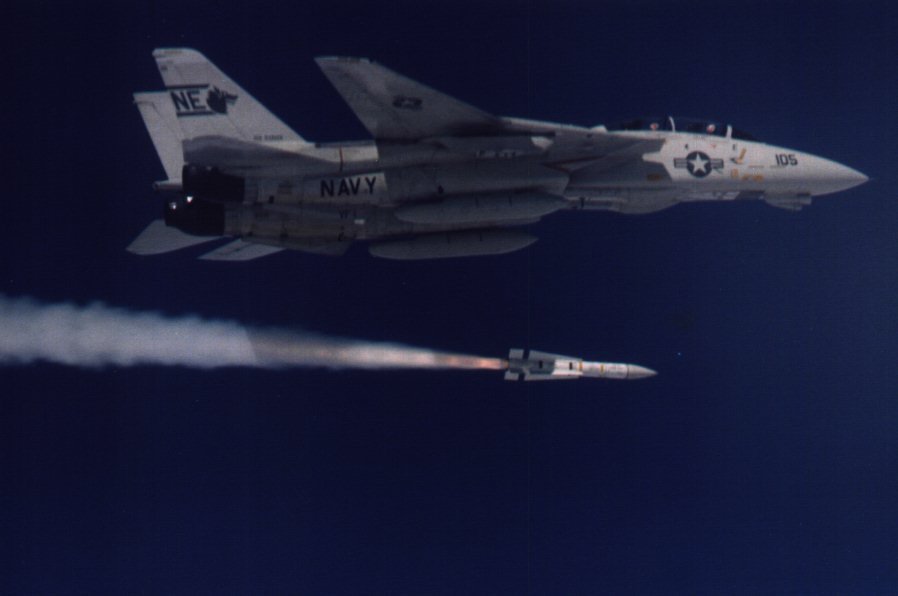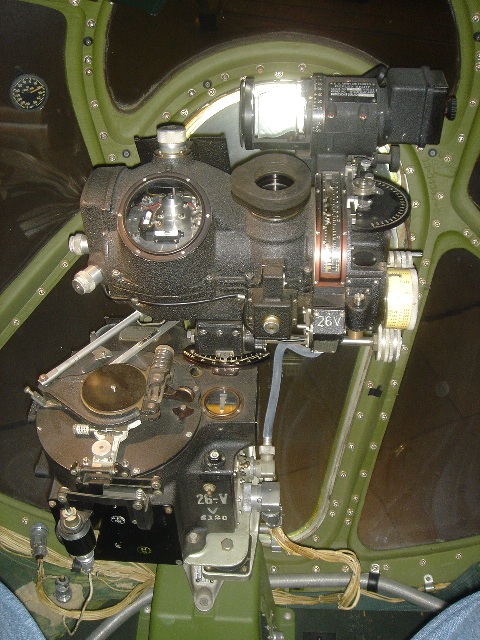Last Trap of the Tomcat – Part II

I began this post on 2/22/2006. I filed it as a draft. Today, whislt driving about for work, I began to ponder the effect of the F-14 Tomcat on my “generation.” Part I will cover some history, and in that, a discussion of how/why the Military gets such toys, and also why it quits using them, too.
Military.com reports the last F-14 combat mission ever has occurred.
The “Anytime, Baby!” guys got their airframe about the time I was commissioned. A few years later, as counter-battery in the recruiting wars, the Navy gleefully helped Hollywood make “Top Gun.”
I stopped there, but had captured the article. Here we go….
The Tomcat went into service the same year I did, 1972. It, as with all other equipment the US Military buys, was bought with a purpose in mind, with the operational requirements laid out by a bunch of people trying to project into the future, many years before then. Being a major procurement program to replace the McDonald F-4 Phantom II, the entire process received an equivalent amount of scrutiny by all levels of government.
The story within this story is instructive for those who often wonder “What were they thinking?” when they see some piece of expensive military equipment being a perceived “misfit” in it’s role of the moment. The beginning of a development is a “threat assessment.” What does the bad guy have now (since you just got surprised) or what do you think he is building, based on available intelligence? The answer to the threat assessment then makes the “OR” (operational requirement) pretty clear. You have to be able to counter the threat. The ORs come from the “Fleet” (in the case of the Navy), making sure the people currently assigned to the duties of war fighting make the major input to the capabilities the new system will have to meet. Shore duty “pukes” and contractors have to sit on the side lines and bite their tongues, or lobby at the bar after the big meeting, hoping to get their 2 cents into the equation. The purpose is keep the people who are not going to have their body parts on the line from “gold plating” projects, at the expense of the tax payers’ good graces. For all the grumbling about these decisions, know it’s a pretty good system to keep costs down, but, yes, sometimes a really expensive hammer does show up in a project plan.
Along the way in all of this, the ORs become reality when the actual contractor is chosen to build the item. In most all cases, this comes many years later, and the warfighters who suffered through the many hours of meetings, at the expense of their professional development, have moved on the retirement or shore duty, and now the people behind them have to keep the flame burning and answering questions of the contractors, the Pentagon at large, and taxpayers. This can be a daunting task, for even if the note taking in the early days was exceptionally well done, there never seems to be the time, nor were many of the side conversations that supported some of the decisions captured to aid in the present discussions. In this, the oversight of the Operational Test Force comes into play, and the project officers “ride herd” on the Fleet guys and the contractors to make sure the equipment does what was laid out in the system requirements, which came from the ORs.
That’s the short way into the F-14 story. In the 60s, the Soviet Union was building up its fleet for defense of the Motherland. While the oceans provided a great buffer, our ability to conduct long range air strikes with several varieties of conventional and nuclear capable platforms, such as the A-3D Sky Warrior, the A-4 Skyhawk, and the A-6 Intruder, the Soviets wanted to take out our carriers before they could get within launch range of the homeland. The counter force to ours was not Soviet aircraft carriers, but massive amounts of SNAF (Soviet Naval Air Force) bombers, equipped with supersonic cruise missiles. Additionally, they put guided missile submarines (SSG/SSGN) to sea, and also put the missile capability aboard surface ships, mostly of the cruiser size, when it was a missile designed to sink air craft carriers quickly.

Soviet TU-16 “Badgers,” TU-95 “Bears,” and later TU-22 “Blinders” and TU-160 “Backfires” would come in massive formations, guided towards CVBGs (Carrier Battle Groups) by forward observer platforms, usually of the TU-95 “Bear D” variant, using it’s underslung “Big Bulge” search radar and video data link to pass the information of the location to the armed aircraft, submarines and surface ships, waiting over our long range radar horizons. The bombers would be armed with cruise missiles that were essentially the size of a small fighter aircraft, packed with explosives. The AS-2 “Kipper,” AS-4 “Kitchen,” -5 “Kelt,” and -6s “Kingfish” were all in this category, capable of being launched from 100 to 200 miles from the carriers. The AS-4 and -6 were particularly nasty, as the climbed high, then approached at several times the speed of sound, and then pitched over towards the target at a very steep angle, making it exceptionally difficult for our gun systems to track and engage the missile in its terminal phase (think ORs for those gun systems that did not envision that threat capability when they were developed, rather than people consciously building a “bad” system).
Welcome to the party the Grumman F-14 Tomcat. Admiral “Hammerin’ Hank” Mustin, while the Second Fleet Commander, often stated his doctrine of “shoot the archer, not the arrow” to say the easier shot is the one at the sub, or not too supersonic, large profile bomber, than to deal with multiple, small, high speed inbound cruise missile, and the F-14 did this in spades. Capt Lex may yuck it up that the F-14 is gone, but even he knows it was the right platform for its time. In a match up between the two aircraft for some DACT (dissimilar aircraft training), and “BVR” (beyond visual range) weaponry being used as it was intended, the “Anytime, Baby!” aviators would be the first ones back with notches in the belts, drinking a few at the O Club and saying things like “Yeah, we had them on radar in plenty of time to smoke them like cheap cigars at about 100NM. You should have heard them whining all the way to impact about how it was so unfair for us to have Phoenix onboard!”
>/p>

The AIM-54 Phoenix missile, targeted by the AN/AWG-9 radar was more than a match for the Soviet bombers. Being able to be punched off the deck with 6 AIM-54s, it could “buster” (in afterburners) out to Combat Air Patrol (CAP) station on a threat vector quickly (combat radius of 500 miles +), being capable of doing more than twice the speed of sound (think 1500+ mph as a round figure, and BTW, that’s Mach 2+!). The AWG-9 radar could scan a sector, and simultaneously track a target for each missile. The AIM-54 range was demonstrated to be in excess of 100 NM. Add a CAP station about 200 miles down the threat axis and a few sections of F-14s, and the bad guys were going to have tough sledding to reach their launch points. More than likely, they would be swimming with the fish before they could get their cruise missiles off their rails, which, from my perspective, was a very, very good thing. Oh, I forgot to mention, not only could these cruise missiles of the Soviets go really fast, and carry a lot of explosives (enough to do serious damage to an armored aircraft carrier), they could carry nuclear warheads, as well, which meant those of us in the “screen” in small boys, or aboard the supporting oilers and ammunition ships in the vicinity would be in serious danger as well. I really liked the idea of the F-14 being the main fighter in service.
Compare and contrast this with the oh, so sexy “lawn dart” known as the F/A-18 Hornet. Is this an aircraft the pilots dearly love? Does it have a really cool radar that does serious magic, can be used in air-to-air or air-to-ground modes? Yes, it does. Can it be equally at home yanking and banking in ACM (air combat maneuvers), as well as “mud moving?” Yep, that too. Can the Hornet dogfight successfully without having the jettison stores meant for a ground target? Check. Does the Hornet have the “legs” to get way out on station and still put a major hurting on a bomber with a 200 NM reach? Not so sure (with out lots of tankers, which then decrements the number of fighters being fighters)? Nope. Interestingly enough, the initial OR for the F/A-18 had a combat radius that wasn’t attainable during operational testing. It seems the then SECNAV, John Lehman directed the combat radius for the F/A-18 in the test documents be lessened, so that we could get the production rolling, hence the knick name of “lawn darts” being applied. Toss them up, and they come back down. The F/A-18E/F “Super Hornets” that came along later provided more fuel tank space in the wings, addressing this issue.
Enough for now….if ou’ve hung on this long, stay tuned for Part II, where I will discuss how the Tomcat was a revolutionary aircraft in the annals of the Navy from a personnel perspective…
Thanks to Mudville Gazette for the Open Post!
Thanks to Little Green Footballs for the Open Thread!







